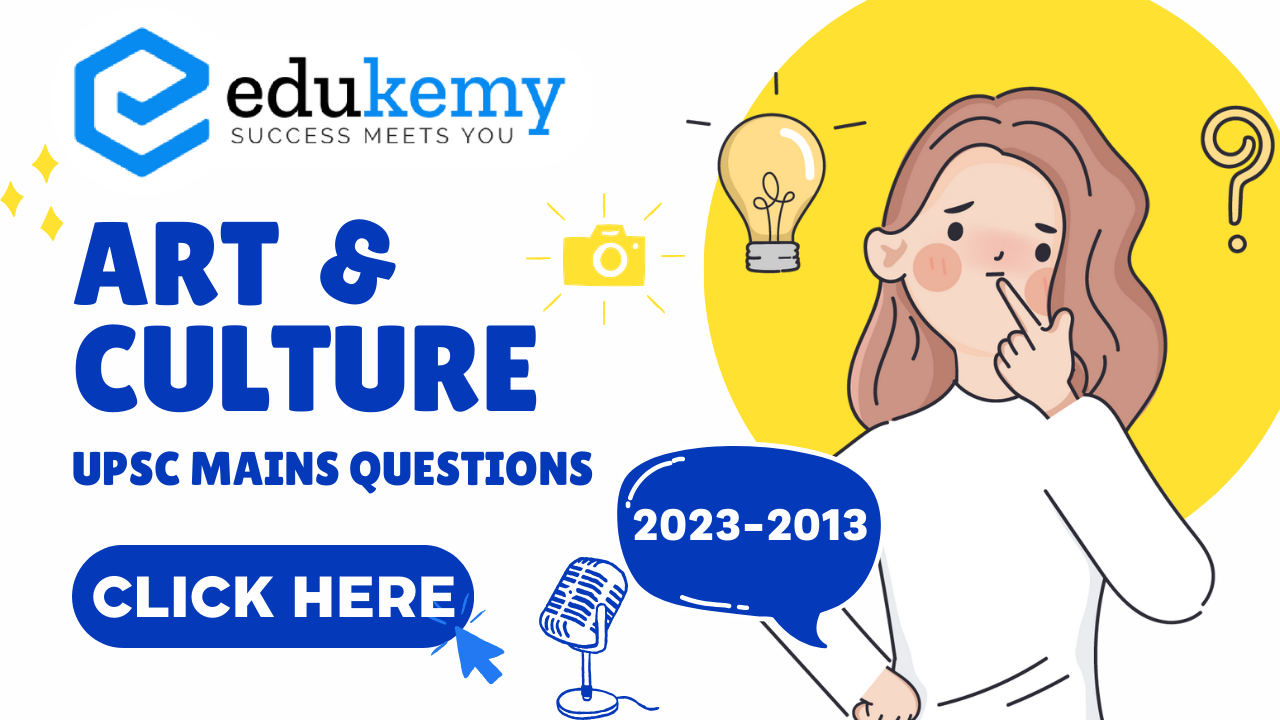Art and culture play a crucial role in our lives. From the vibrant folk dances to the intricate sculptures, the rich cultural heritage of India is a treasure trove of diversity and creativity. For UPSC aspirants, Art and Culture is a critical topic as it holds significant weightage in the main exam. The subject includes various facets such as architecture, music, dance, theatre, literature, and painting, to name a few. In the previous year’s main examination, several questions related to art and culture were asked, highlighting the importance of this subject for the exam. Therefore, aspirants must have a comprehensive understanding of the topic to score well in the exam.
To excel in the Art and Culture section of the UPSC Mains exam, aspirants must focus on building a strong foundation. A thorough understanding of the various art forms, their history, evolution, and their significance in society is essential. Additionally, aspirants must keep themselves updated with the latest developments in the field of art and culture, such as new forms of art and their impact on society. Regular practice of answering previous year’s questions and mock tests can also help in developing the necessary writing skills required to ace the exam. With consistent efforts, dedication, and a passion for art and culture, aspirants can undoubtedly excel in this section of the UPSC Mains exam.
Art and Culture Questions
2023
NIL
2022
2. Discuss the significance of the lion and bull figures in Indian mythology, art, and architecture.
2021
1. Evaluate the nature of the Bhakti Movement and its contribution to Indian culture.
2020
2. The Pala period is the most significant phase in the history of Buddhism in India. Enumerate.
4. Persian literary sources of medieval India reflect the spirit of the age. Comment.
2019
1. Highlight the Central Asian and Greco-Bactrian elements in Gandhara art.

2018
1. Safeguarding the Indian Art Heritage is the need of the moment. Discuss.
2017
2016
2015
2014
2. Gandhara sculpture owed as much to the Romans as to the Greeks. Explain.
2013
2. Discuss the Tandava dance as recorded in the early Indian inscriptions.
3. Chola architecture represents a high watermark in the evolution of temple architecture. Discuss.
Frequently Asked Questions (FAQs)
1. Question: Discuss the significance of the Chola bronzes in the history of Indian art.
Answer: The Chola bronzes, dating back to the 9th-13th centuries, represent a pinnacle in Indian artistic achievement. Known for their exquisite craftsmanship, these metal sculptures primarily depict Hindu deities and stand out for their realistic anatomical details. The bronzes played a crucial role in religious and cultural practices, serving as both objects of worship and artistic appreciation. The intricate casting techniques and the spiritual symbolism embedded in these sculptures make them a cornerstone in the development of Indian art.
2. Question: How did the Mughal architecture contribute to the cultural amalgamation in medieval India?
Answer: Mughal architecture, characterized by its fusion of Persian, Indian, and Central Asian elements, stands as a testament to the cultural amalgamation during medieval India. The construction of iconic structures like the Taj Mahal and Red Fort not only showcased architectural brilliance but also reflected the synthesis of diverse artistic traditions. The use of intricate geometric patterns, dome structures, and incorporation of local craftsmanship into Mughal designs exemplify the harmonious blend of different cultural influences during this period.
3. Question: Analyze the role of classical dance forms in preserving and promoting Indian cultural heritage.
Answer: Classical dance forms in India, such as Bharatanatyam, Kathak, Odissi, and others, have played a pivotal role in preserving and promoting the country’s rich cultural heritage. These dance forms are not just artistic expressions but also repositories of historical narratives, mythology, and social values. Through intricate mudras, expressions, and storytelling, classical dance serves as a medium to transmit cultural knowledge across generations, fostering a sense of continuity and pride in India’s artistic traditions.
4. Question: Elaborate on the evolution of Indian miniature paintings and their contribution to visual arts.
Answer: Indian miniature paintings have evolved over centuries, with distinct styles emerging in different regions. From the delicate details of the Mughal miniatures to the vibrant colors of the Rajput paintings, these artworks provide a visual chronicle of India’s cultural and historical diversity. The miniatures not only served as aesthetic delights but also conveyed stories, courtly life, and religious themes. Their contribution to visual arts lies in their ability to encapsulate narratives in a confined space, showcasing the artistic prowess of Indian painters and their role in shaping the country’s visual cultural identity.
5. Question: Evaluate the impact of cinema on Indian society and its role as a cultural mirror.
Answer: Indian cinema, often referred to as Bollywood, has been a powerful cultural force shaping societal norms and reflecting the complexities of Indian life. Serving as a mirror to the nation’s socio-cultural milieu, cinema addresses issues ranging from gender roles to economic disparities. The portrayal of diverse landscapes, languages, and traditions in films contributes to national integration. Furthermore, cinema acts as a catalyst for social change by addressing taboo topics and fostering dialogue. The influence of Indian cinema extends beyond entertainment, playing a significant role in shaping perceptions and fostering a shared cultural narrative.
To get free counseling/support on UPSC preparation from expert mentors please call 9773890604
- Join our Main Telegram Channel and access PYQs, Current Affairs and UPSC Guidance for free – Edukemy for IAS
- Learn Economy for free- Economy for UPSC
- Mains Answer Writing Practice-Mains Answer Writing
- For UPSC Prelims Resources, Click here

